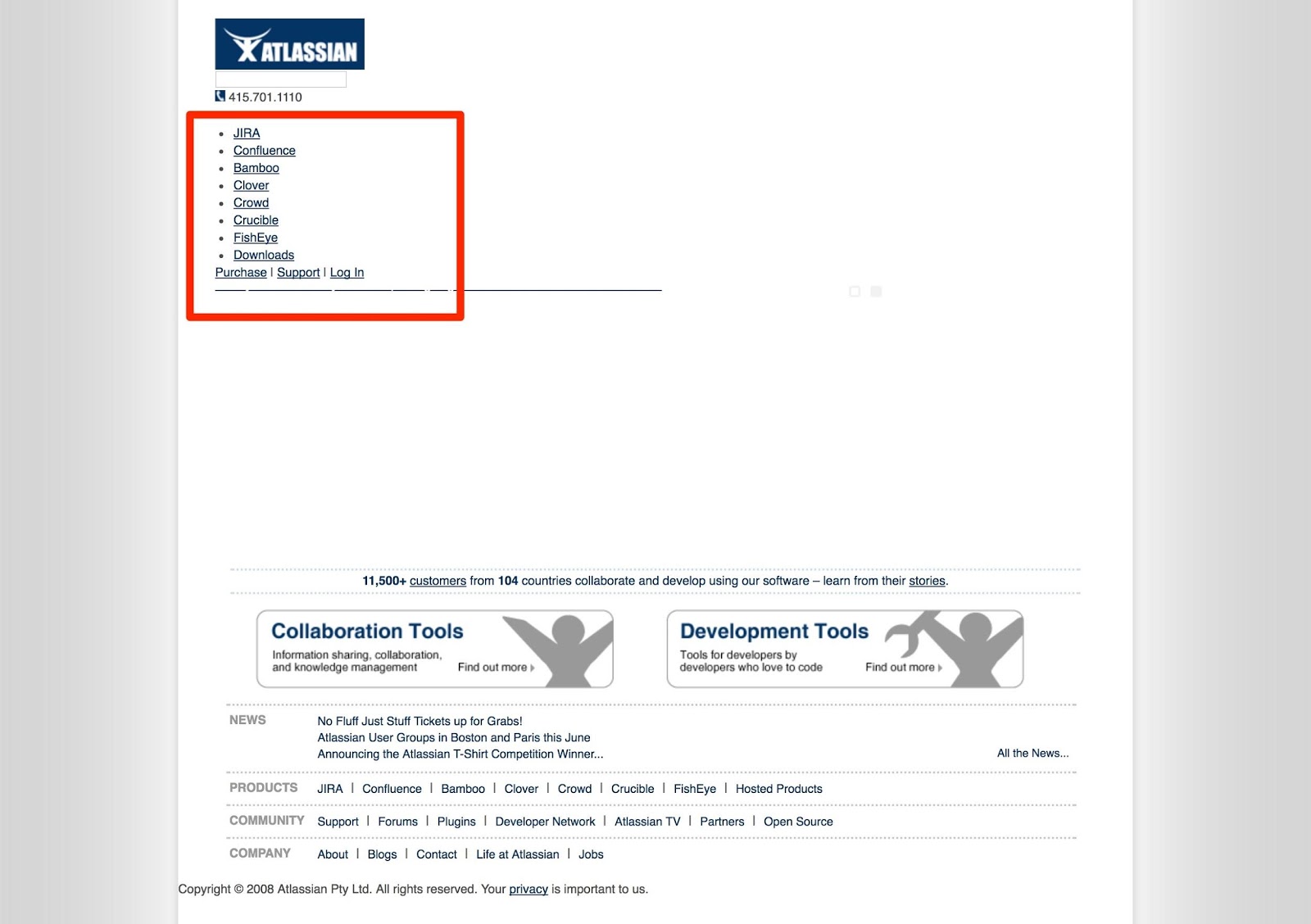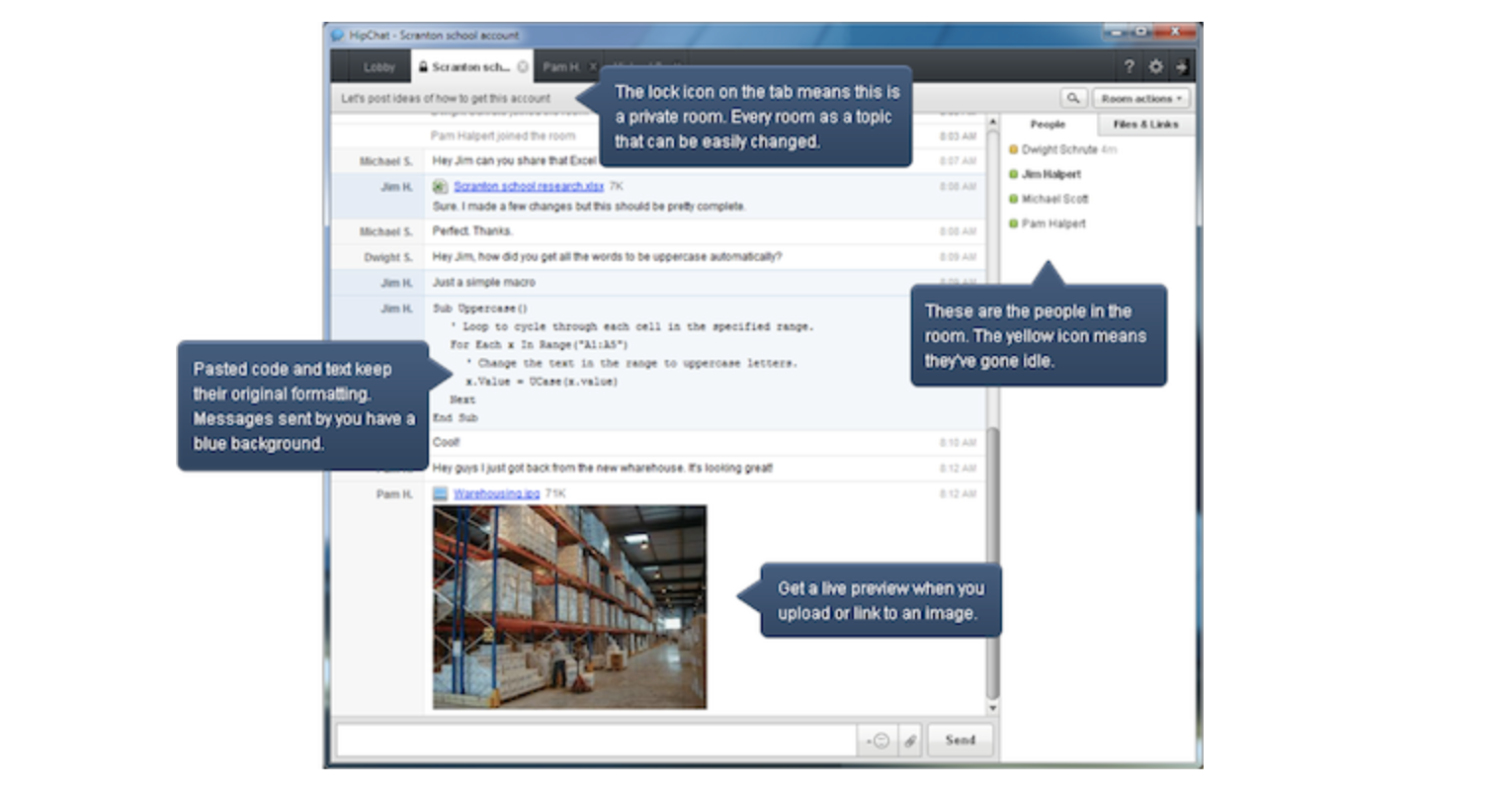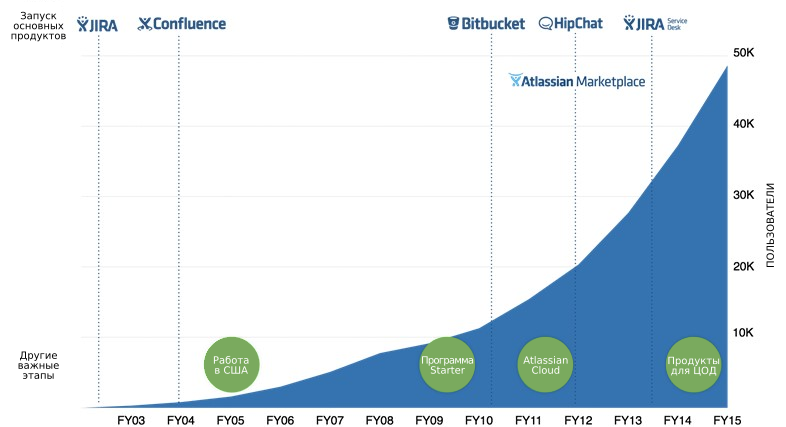How Atlassian has built a $ 10 billion business. Part 1

"There were a lot of smart people who were not going to join our company, give money or advice - because our business had no meaning for them."
- Mike Cannon Brooks, co-founder of Atlassian
When Atlassian was just emerging (in 2002), its founders had a choice.
On the one hand, they could go the usual way and do what most SaaS companies did: dial the sales department, knock on the doors of investors and try to turn the idea into millions of dollars in the form of financing.
However, the founders of Atlassian did not go that (expected) way - they decided to act differently, and this eventually allowed them to build a business worth $ 10 billion.
')
Transferred to Alconost
After 15 years from the date of foundation, Atlassian still has no corporate sales department. The most powerful and unusual growth lever has been the constant acquisition of other products — throughout the company's history — and their integration into the existing set of solutions. This has helped Atlassian grow a family of products that can be fairly harmoniously distributed among corporate organizations.
But how exactly did they manage to organize growth through the acquisition and integration of other solutions and build their own international business on this? Let's take a closer look at the following questions:
- Developing a loyal market by creating a best-in-class project management tool for development teams.
- Strategic expansion of the range of its products through acquisitions - in order to expand the client base, starting from the development teams .
- In purchased products - a bet on distribution according to the “minimum free” model (“freemium”) and horizontal use scenarios — in order to expand the product funnel to other departments of organizations.
Many Atlassian approaches for their time were unique, and now they have become common practice in SaaS companies. Let's look at how, due to the specific needs of the Atlassian team, as the company developed, some of these methods of work appeared and how they contributed to the success of the company.
2002–2010: self-financing and the minimum free model
In 2002, just when the “nuclear winter” ended in technology, it was difficult to be an entrepreneur in Silicon Valley - but starting up in Australian Sydney was much more difficult: there was not a large technological community, there were no local venture funds that could would go for the investment. The founders of Atlassian, Mike Cannon-Brookes and Scott Farquhar, describe the situation this way: there was no such IPO (initial public offering) tradition as in Silicon Valley.
They had the idea of a new tool for developers, but there was no money - so it was clear that to create a successful company you would need:
- Quickly create extremely useful tools so they can conquer the market.
- Find a way to sell them without spending on the sales department.
Since the founders of the company themselves were developers, they saw the need for specialized developer tools covering problem tracking and collaboration. They implemented this functionality in the first two tools - Jira and Confluence.
Prior to that, no one had done project management and collaboration tools specifically for developers, and the founders knew from their own experience that there was a need for such solutions. It was necessary to force developers to try these tools. Therefore, it was decided to use the “minimum free” model: this way users could test the tools without risking money and understand how useful they were.
Thanks to this approach, a lot of people immediately began to use the company's solutions, and since clients brought money without spending on the sales department, the team was able to acquire other companies at the early stages of their activities and add their products to their proposals for developers.
Let's take a closer look at how in the very first years the initial products were created (and acquired), which allowed us to conquer the market of tools for developers.
2002: Cannon Brooks and Farquhar study computer science at the same university and meet there. By that time, they already knew that they wanted to create their own company - and they began with the organization of a third-party support service. At the same time, they wrote their own problem tracking system: they were tired of using e-mail and single-user organization tools to monitor development progress. Software development is not the most streamlined process, so we needed a special tool that would allow us to register problems and organize joint work. It soon became clear that the solution used inside the company could bring tangible benefits to other developers - so they decided to move from providing services to a grocery company. To found Atlassian, Scott and Mike borrowed $ 10,000 on a credit card and launched their first flagship product, Jira.

The program was distinguished by a simple interface and was a universal tool for organizing work with errors, planning functions and tracking tasks. There was also the ability to view version history, search for registered errors and add file attachments — everything a developer needs to manage software projects. Prior to that, none of the tools had such functionality.
Due to the wide coverage of the issues being solved and the complexity, the learning curve in the Jira system was quite steep. But in the specific market where Atlassian worked, this turned out to be a huge advantage: the reason for the complexity of the training was that the tool had everything necessary for tracking errors, and it could be customized exactly as developers need in specific teams and on specific projects - and For this, Jira fell in love with the development teams.
2004: Jira generates revenue, but the Atlassian team is already beginning to look for other potential sources of revenue. Among developers, the wiki technology gained popularity, and the founders of Atlassian decided to take advantage of this and give teams that needed a corporate information management system a simple wiki system. A new interaction platform for the development team called Confluence . It was intended for those teams that already used Jira, and had to expand their capabilities with the functions of creating, editing, organizing wiki pages, creating links to them and searching them.

Confluence system was neatly integrated into the Jira system, which was already beginning to win love among developers - that is, the new product worked perfectly with another specialized and very useful product, which pushed users to try Confluence.
The decision to develop a new product after the success of the first one seemed risky: many companies initially tried to fully concentrate on one thing. If you divide the resources, there was a danger of failing both products. But the team was confident that Jira really liked the users, and understood that Atlassian could give them other tools. As a result, the development of several products justified itself. Mike says about this: “We were dragged not by one, but by two jet engines”.
2005: without spending a single dollar of venture capital, Atlassian made a profit only three years after its foundation. The reason is simple - the prices of the products were corporate, but it did not have to spend money on the sales department: the product had a 30-day free trial on the company's website, after which users had the opportunity to upgrade to a paid data plan. Thanks to this, developers could try out the proposed solutions, understand how useful they were, and then recommend them to team members and fellow developers.
2007: Jira and Confluence sales grew, and this confirmed that the development teams were a market with great potential. But here, Atlassian made an interesting and unique move. Usually, companies that offered corporate tools for developers expanded to develop new products. However, the Atlassian team already had capital, so they decided not to waste time developing many of their own tools, but instead buy those that were already successful.
By making this decision, they turned their attention to Cenqua, which had three of its own developer tools: Fisheye, Crucible and Clover, these tools filled the gaps in the Atlassian product family. Mike noted on this occasion that some of the functionality of these tools , such as checking the code from Crucible, was incredibly helpful to developers. He said that "on a scale from one to ten, the strategic match [Cenqua tools] is ten."
By incorporating new products into its offers, the company made it possible for the services to continue to work, but transferred all the information and documentation on the products to the Atlassian website. The management staff and all the developers of Cenqua went to Atlassian. By 2008, Crucible’s tools on the Atlassian website were already listed along with the rest of the products and were part of a complete package of products.

Such an acquisition in the early stages is a rather unusual move, especially considering the lack of venture financing. However, the “minimum free” sales model helped the company quickly generate high returns. After weighing the pros and cons, calculating the time and money required to develop their own version of such tools, the Atlassian team came to the conclusion that the acquisition of Cenqua is the best investment.
The sales and distribution model used, as well as early acquisitions, created many sources of income, which by 2010 made it possible to achieve an average profit margin of $ 50 million. At this point, the company was eight years old, and it brought profit for five years.
It was clear that Atlassian did not need venture capital funds for survival: the company had built a fairly independent system. But in the long-term plans, the company had its own reasons for working with investors in the next stage of growth.
2010–2015: integration of acquisitions and distribution to other teams
“We want to build a business that will last 50 years. And the transition to a public company is one of the stages of movement towards this goal. There are few long-livers among closed joint-stock companies. ”
- Scott Farquhar
Unlike many others, Atlassian did not attract money “for life”: they already had a successful business model that captured the market with the help of useful tools for developers.
The early success of the Jira, Confluence and Cenqua products inspired the team and proved that the distribution model chosen was quite working. The company realized that creating a family of necessary product developers can become indispensable and retain customers in the long term. After the success of the first acquisition, it was decided that the best way to move on would be to deliberately purchase products and build an Atlassian family from existing solutions.
Let's see what Atlassian team has done in order to purchase the right products, integrate them correctly and expand their user base, including users who have no direct relationship to the developers.
2010: Atlassian attracts $ 60 million in additional funding from venture capital firm Accel Partners - eight years after its foundation. The funds received in the form of investments were planned to be used in order to expand opportunities for acquiring other companies and growth. The team said that the capital will go to absorb other corporate tools that should complement the functionality used by developers and help the company begin to expand in other directions.
At this point, Atlassian had more than 20,000 customers worldwide, including Facebook and Adobe, so there was a need to offer an even more reliable and functional set of tools for developers. So, in an effort to start doing what “Adobe does for designers, only for technical teams,” the Atlassian team tried to figure out how they can help developers manage projects in other stages of the pipeline.
As a result, the company acquired Bitbucket, a service for collaborating on code (the amount of the transaction was not disclosed), which provided developers with joint access and collaboration in a decentralized software repository. In one of the reports, it was noted that thanks to the acquisition of Bitbucket from developers within the Atlassian family, there was now “a place where you could put code, as well as a tool for tracking problems and errors in projects”. Thus, this product perfectly filled the gap in Atlassian sentences. Atlassian offered it along with the rest of the solutions and formed a new pricing policy, including a “minimum free” plan - in order to easily fit Bitbucket into the existing distribution model of its products.
2012: Atlassian acquires the HipChat private chat service and announces plans to integrate the chat function into its product family. It was a brilliant decision that showed that Atlassian was ahead of its time: Slack had not yet “fired”, so the acquisition of a real-time communication tool was not an obvious step. The Atlassian team used HipChat in their own work and knew how useful it was - so they wanted to give their users the same built-in functionality.
HipChat grew by leaps and bounds and served more than 1,200 customers, including Groupon and HubSpot. And no wonder: this decision helped to establish communication in entire organizations. HipChat CEO and founder Pete Curley (Pete Curley) said that Atlassian is an ideal environment for quickly scaling Hipchat services and separately noted a well-built business model. By purchasing HipChat, Atlassian was able to close another gap in its offers and draw attention to its own products from a larger number of non-developer teams. As Cannon Brooks put it , HipChat "is ideal for product teams, but remains an amazing tool for others."

A source
2013: Atlassian, in addition to the system, Jira launches a proposal for technical support, aimed at the IT market. Among the new features were the following : a client-oriented interface, an SLA (Service Level Agreement) engine, customizable department queues, and real-time reports and analytics.

Atlassian President Jay Simmons said that this addition harmoniously covered the needs of Jira customers: about 40% of Jira users have already expanded to service those. support or service department and asked Atlassian to develop an appropriate service. Solution for those services. support helped extend Atlassian's offers to IT departments and increase the number of orders — at that time they were more than $ 100 million a year .
2015: Atlassian's Git services are growing rapidly: Eric Whitman (Eric Wittman, director of tools for developers) noted that the growth of Bitbucket customers a year earlier was about 80%, and that Bitbucket was used in every third Fortune 500 company. in line with such growth and becoming a solid brand, Atlassian combined all its Git-based services under the Bitbucket brand and added support for larger distributed teams and projects.

Over the years, the Atlassian team filled a gap in SaaS-based team tools and presented a broad vision of team collaboration. Many companies acquire other products, but in most cases they do not do very well with integration. The merger of two independent companies can become a nightmare where problems of brands, personalities and even code bases will be implicated. The Atlassian team has not only learned how to acquire products wisely - they have mastered the exquisite integration skills, from people to code.
This strategy was based on product connectivity: in the case of well-integrated solutions, it is not necessary to have one perfect tool — for successful sales it must be an integrated function for the entire set of products. It didn’t matter whether any company preferred Github’s platform to Bitbucket — if Jira and Confluence were already used in the team, Bitbucket would be used, as this makes the workflow more convenient and efficient.
This strategy was directly related to the Atlassian product distribution model: they took a small price for the initial products and sold a small number of jobs. Each product had its own pricing model, so teams could add tools at their discretion. And in most cases they started with a free trial.

Jira system prices in 2015
Pretty soon, this flywheel was unwound: more and more individual employees and entire teams were connected, who eventually realized that it would be difficult to work without Atlassian tools.
The goal of the company was to make a single all-consuming whole from separate parts. And from the point of view of the efficiency of attracting customers, this approach worked: in the period from 2012 to 2015. the company spent from 12 to 21% of annual income on attracting customers, while the median in the SaaS industry was 50–100%.
With the addition of new products, Atlassian has found new ways to attract customers to the Jira solution - as is the case with Bitbucket for developers and the Hipchat service for the rest. This has led to a sharp increase in user and revenue.

A source
The first few Atlassian products — including Jira and Confluence — brought in a small but steady income. Acquisitions have allowed Atlassian to expand and grow with each new product. Shortly before the company's IPO, an annual turnover of $ 320 million was announced - 60% more than a year earlier.
Atlassian was able to bundle the distribution flywheel and the scheme of acquiring and integrating new products. She was ready to expand the top of the food funnel and try to win the hearts of an even greater number of divisions in various companies.
About the translator
The article is translated in Alconost.
Alconost is engaged in the localization of games , applications and sites in 68 languages. Language translators, linguistic testing, cloud platform with API, continuous localization, 24/7 project managers, any formats of string resources.
We also make advertising and training videos - for websites selling, image, advertising, training, teasers, expliners, trailers for Google Play and the App Store.
Read more: https://alconost.com
Source: https://habr.com/ru/post/347504/
All Articles